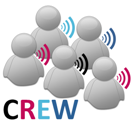Application
TWIST
Short testbed description
The TKN Wireless Indoor Sensor Network Testbed (TWIST) is a multi-platform, hierarchical sensornetwork testbed architecture developed at the Technische Universität Berlin. One instance is currently deployed at TUB campus: a total of 204 sensor nodes (102 eyesIFX and 102 Tmote Sky nodes) are distributed in a 3D grid spanning 3 floors of an office building, resulting in more than 1500 m² of instrumented office space. Two nodes of each platform are deployed, while the larger ones (~28 m²) have four nodes.
Example experiments
Various experiments can be performed using the TWIST infrastructure, for example:
- Investigating different RF interference detection techniques, e.g. distributed vs. centralized detection.
- Exploring different interference mitigation techniques, such as frequency hopping or adaptive power control.
- Studying spatial distribution of RF interference in an office environment via RF interference maps.
Experimenters may also couple the TWIST testbed with mobile sensor nodes (carried on a human subject or by a mobile robot) or spectrum analyzers in order to, for example, investigate:
- Cooperation between fixed infrastructure and mobile body area networks (investigating network discovery, handover, etc.)
- Comparison of in-network interference detection with other (external) spectrum sensing equipment
Access information
TWIST is accessed via a web-interface. Experimenters can install their firmware on one or more sensor nodes, receive status information, download experiment traces, and interact with individual nodes during an experiment over an SSH connection. The mobile robot can only be accessed locally.
Demonstration
After applying for an account, a set of tutorials is offered to get you started right away.
Getting started and user documentation
Access the complete documentationw-iLab.t
Short testbed description
The iMinds w-iLab.t allows flexible testing of the functionality and performance of wireless networking protocols and systems in a time-effective way. It provides remote access to hardware that can be remotely controlled and reconfigured, automated experiments can be scheduled, and experimental results can be collected, processed and visualised.
Example experiments
A wide range of experiments is possible on w-iLab.t. Below, we first list three possible experiments and then list experiments that have been performed on the testbed within the CREW project:
Three representative examples of cognitive networking experiments are as follows.
- Interference avoidance in the 2.4 GHz ISM band: activate a subset of nodes (both sensor nodes using 802.15.4 and Wi-Fi nodes. Implement interference avoidance protocols on top of the sensor node and/or Wi-Fi node. Check the impact on the spectrum using the imec sensing engines installed in the testbed.
- Distributed via centralized sensing approaches: compare the difference between different sensing algorithms, e.g. installed on sensor nodes
- Performance of low-cost sensing modules: find out how accurate RSSI readings collected by sensor nodes are when implementing a certain channel-sampling algorithm on top of these nodes. Compare this with the performance of high-end sensing solutions, based e.g. on USRPs or imec sensing devices located in the same environment.
Experiments performed during some of the Open Calls of the CREW project:
-
Determine the sensitivity of various Cognitive Radio sensing engines to low level received signals with and without modulation. Watch video here.
-
Perform radio channel measurements to study the effects of the environment on the received signal. Watch video here.
-
Perform energy efficiency and delay evaluation of Spectrum Sensing platforms and algorithms. Watch video here.
-
Demonstrate self-adapting access mechanisms that are able to switch from standard DCF to a TDMA-like access scheme in case of hidden nodes. Watch video here.
-
Demonstrate the functional architecture of the control channels for the cognitive management of capacity and coverage extensions of the wireless access infrastructures. Watch video here.
Access information
Experimenters may use (= install firmware, code, software, images,... on one or more nodes, view status, download results,...) the testbed remotely via an OpenVPN connection over the internet. Most interactions are performed via a web interface, although direct connections to devices over SSH is also possible. The testbeds at both locations (Office, Zwijnaarde) are accessible 24/7, with the restriction that Wi-Fi experiments are not allowed at the Office location during office hours. Usage is bound to a negotiable quota in function of the type and amount of infrastructure needed. Please check the basic w-iLab.t tutorial for details on how to get an account.
Demonstration
- General introduction movie to the w-iLab.t
- Information is available from the iLab.t documentation website












